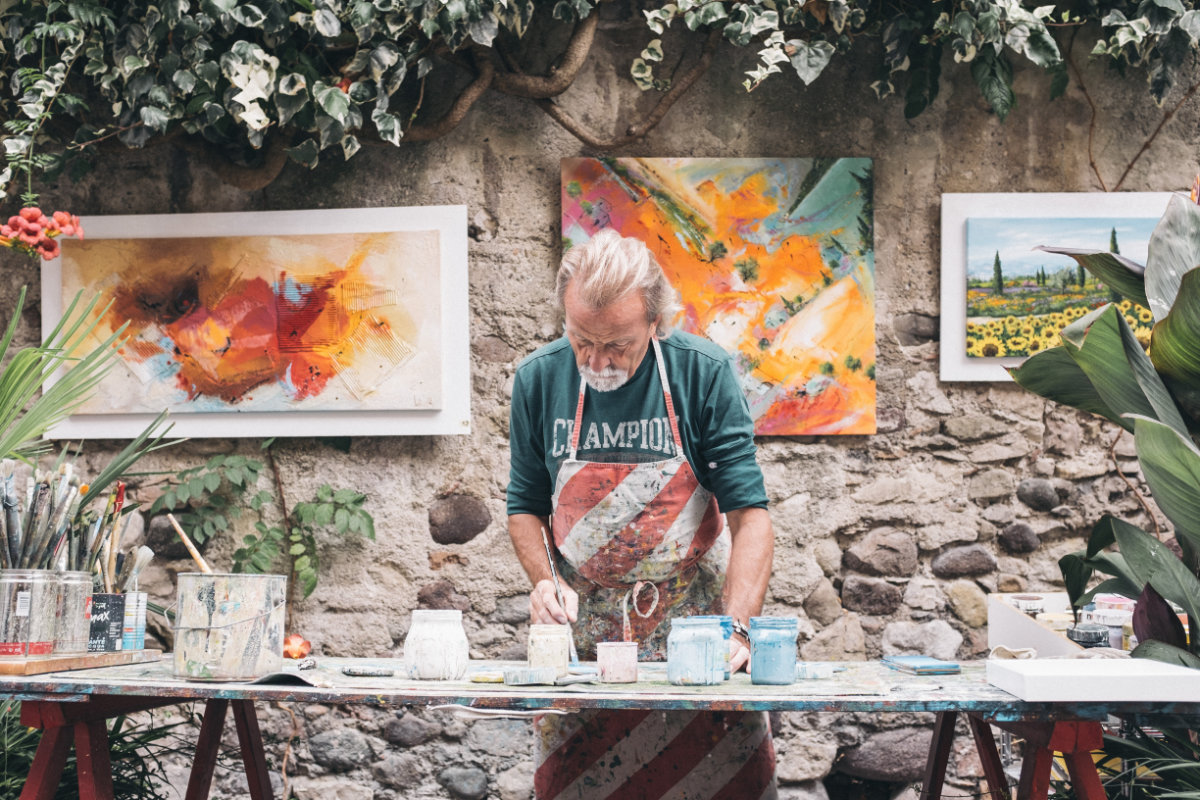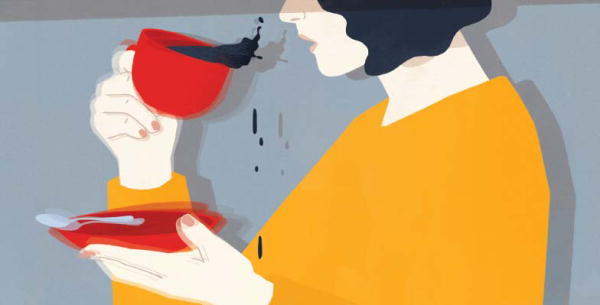Having essential tremor doesn't stop you from being an artist!
Norman Eason speaks with authority and passion about painting and how it is fun and challenging. His message is “Enjoy it and remember that although we may never be as good as we want to be, we will invariably be better than we used to be.”
I am 70 and for 35 years – half my life – painting has been my main hobby. But I have had Essential Tremor (ET) since birth, and for all of my life I have had to find ways to cope with it. Of course, when I was young, the term 'Essential Tremor' was unknown and throughout my schooldays I was considered to be 'the nervous one'. My headmaster even kept me back a year because my twin had poor exam results (and I had done well) because he thought that being with my twin would help my nervousness!
Lest you think that my tremor must be mild if I can paint, I have lost count of the number of cups of tea and coffee that I have spilled and, now I'm older, my tremor is getting worse. But as I am retired, the pressures to conform are far less and I no longer have to sit through meetings with a cooling cup of coffee in front of me, more worried about whether I should risk lifting the cup than about the meeting itself!
Here are my tips for painting with ET
- Paint at home using photos as a reference rather than on site. Your tremor will be better if you are calm, and there is nothing worse for your stress than someone looking over your shoulder! You can transfer the picture accurately from the photo to your board or canvas by drawing squares on both and sketching the detail within the squares as the basis of your painting.
- If you are an absolute beginner, try learning from books or DVDs. Classes can be competitive and stressful – especially if you are the only student with shaky hands! You may be lucky and find a considerate tutor, but other students may resent any additional time that they spend with you.
- Paint on a large board or canvas – say around 20 x16 inches. With ET, we are never going to paint miniatures! So, extend this thinking to help you by painting subjects that will be viewed from several feet away rather than up close. We have all spotted good paintings from the other side of a gallery which, when viewed up close, are totally different because they are meant to be seen from several feet away.
- Stand up to paint with your painting on an easel. This allows you to keep moving back and forward to view the painting at the position where most viewers would look at it. If you have to sit down to paint, get up occasionally to look at it from further away. This also helps to keep you from getting involved in too much detail.
- Choose your painting medium to suit your tremor! Almost every introductory painting course and book starts novice painters off in watercolours. This is crazy! Watercolour is the most unforgiving of all painting mediums. With watercolours, you have to plan out where every white will be, make sure that you apply colours darker than you intend because they will dry lighter, make sure that paint is dry before applying an adjacent colour, etc., etc.! Now I have nothing against watercolour – I started with watercolour and painted solely in this medium for 15 years. But it is the most stressful of all painting mediums and those of us with ET can do without added stress!
Pastels are a lovely medium. I enjoy using pastels, although they can be a bit messy! Chunky pastels are also easier to use for those with ET, so paint on a large sheet and keep walking away from the easel to see how well you've done. Pastels are also a very quick medium, so you get added satisfaction more quickly.
Acrylics are also good for those of us with ET. They dry quickly, so if you make a mistake, you can paint over it once it's dried.
My favourite medium, and the one I now use exclusively, is Water-Mixable Oils. This sounds strange as oil and water don't mix, do they? However, this new type of paint has been available for around seven years and has all the good properties of traditional oil paint and dries in a few days instead of weeks. It doesn't use smelly linseed oil or turpentine, and you can thin the paint with water, although I always use it undiluted. But the great benefit is that to clean your brushes you just squirt washing-up liquid on them and clean them under a hot tap! Mistakes on your painting either due to shaky hands or inexperience can be removed with a damp rag or cotton bud. - Never rush a painting. Any paintings that I've rushed to finish in order to try to meet an exhibition deadline have always been less enjoyable to paint than those that I've taken time over. After all, it is a hobby and you are meant to enjoy a hobby! Once you have finished the painting, and possibly paid to have it framed, it is going to be on your wall – or someone else's wall – for a long time. So take your time and enjoy the painting process. Leave the painting on the easel or propped up where you can look at it as you pass. Change it if you see parts that you are not happy with, but don't worry it too much! You will know when it is finished (probably when you or someone else says “WOW”). Although art is almost unique as a hobby in that it is possible to sell the results of your work, don't paint to sell – paint to enjoy yourself and to keep improving. There will always be better painters than us, so the only person you should compete with should be yourself!
- Think about what style you are going to paint in. In section 3 above, I advised against painting miniatures. Similarly, you should avoid painting minute detail in larger paintings. Study the impressionists. It's amazing how a blob of paint can represent a distant person in a painting when viewed from ten feet away! With oils and acrylics, use the largest brushes you can get away with. If you need to add any details, use a Mahl stick to steady your hand. Mahl sticks were used by all the famous artists to help them paint detail, but I have never heard any art tutor suggest their use – perhaps because most people in art classes have no problem with shaky hands!
The old Mahl sticks consisted of canes about two foot long with a ball of cloth enclosed in leather at one end. This ball was about 2 inches in diameter. The idea is to hold one end of the cane and place the other padded end against the board or canvas, so providing a support parallel to the picture upon which you can rest – and steady – your painting hand. I made a Mahl stick using a length of ¼ inch dowel with a small polystyrene ball stuck to the end and have been using it successfully to steady my hand for years. - Some people use painting knives. I have a number of these, but they are not 'tremor-friendly'. They are great, however, for adding that special highlight. I find that I usually require several attempts at highlights because of my tremor, cleaning off each failure with a wet cotton bud each time – but persistence is usually worth it and gives the 'WOW FACTOR' that I wanted.
- Use any tools you feel you need in order to achieve the results you want. There are many art purists who say that you should not paint from photographs. Monet, Cezanne and Van Gogh would have used photographs if they were available! They would also have used masking tape to get straight lines. I find that this helps when painting ships' masts, buildings and windows – but cut it into thin strips and wait until the adjacent paint dries, otherwise the tape will not stick to the wet paint and it will also lift it.
- If you choose oils or acrylics, buy cheap stretched canvases to paint on. You can get these from pound stores. If you choose canvases that are stapled on the back rather than on the sides, then you don't have to frame them. This removes another layer of stress.
- If you have a computer, then there are a number of painting programs available for you to dabble with. Some are free and great fun. You would need to invest in a tablet and pen, but these don't need to cost much – mine is a cheap but very capable tablet made by Trust that I bought at Asda for £22. I use TwistedBrush from Pixarra.com. It has a free edition with a few sample brush types, but you can also trial the complete system with around 5000 brush types for a month for free. Some of these brush effects will just blow your mind! And the great thing about digital art is that you have an UNDO button – so you can quickly clear any mistakes. I use TwistedBrush to help my oil painting by taking a digital photo of the painting when I'm unsure of how to continue, trying out all the possible options (e.g., changing the colour of the sky, adding in another person) using TwistedBrush on several copies of the image, then implementing the chosen solution on the actual painting. Van Gogh would have given his right ear for TwistedBrush!
Get in touch if you'd like to share your story.













